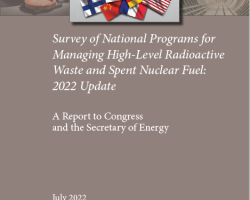Category of Content
Siting Experience Documents Only
Publication Date
Subject Matter
Thermodynamic Database for Generic Disposal System Assessment
Thermodynamic Database for Generic Disposal System Assessment
Modeling Coupled THM Processes and Brine Migration in Salt at High Temperatures
Modeling Coupled THM Processes and Brine Migration in Salt at High Temperatures
Thermo-Hydrological and Chemical (THC) Modeling to Support Field Test Design
Thermo-Hydrological and Chemical (THC) Modeling to Support Field Test Design
Fluid Flow Modeling in Representative Media
Fluid Flow Modeling in Representative Media
Report on THMC Modeling of the Near Field Evolution of a Generic Clay Repository: Model Validation and Demonstration
Report on THMC Modeling of the Near Field Evolution of a Generic Clay Repository: Model Validation and Demonstration
Multiphysics Simulation of DPC Criticality Scoping Calculations and Coupling Strategy
Multiphysics Simulation of DPC Criticality Scoping Calculations and Coupling Strategy
Fluid Flow Model Development for Representative Geologic Media
Fluid Flow Model Development for Representative Geologic Media
Report on Hydrologic Flow in LowPermeability Media
Report on Hydrologic Flow in LowPermeability Media
Thermodynamic Properties of Brines, Minerals and Corrosion Products
Thermodynamic Properties of Brines, Minerals and Corrosion Products
Passive Atmospheric Monitoring in a Vadose Zone Underground Research Laboratory
Passive Atmospheric Monitoring in a Vadose Zone Underground Research Laboratory
LANL Activities in Model Benchmarking and Thermal Test Design Calculations
LANL Activities in Model Benchmarking and Thermal Test Design Calculations
TEST PLAN TO DEVELOP HYDROLOGIC LABORATORY METHODS: EXPERIMENTS OF BRINE MIGRATION IN SALT DUE TO THERMAL GRADIENT AND /OR DEHYDRATION OF SECONDARY MINERAL PHASES
TEST PLAN TO DEVELOP HYDROLOGIC LABORATORY METHODS: EXPERIMENTS OF BRINE MIGRATION IN SALT DUE TO THERMAL GRADIENT AND /OR DEHYDRATION OF SECONDARY MINERAL PHASES
Guidance for Creating a Community Benefits Plan for Regional Direct Air Capture Hubs
Guidance for Creating a Community Benefits Plan for Regional Direct Air Capture Hubs
This document is intended to provide supplemental information to assist applicants developing a Community Benefits Plan (CBP) for the Regional Direct Air Capture Hubs. As shown in the graphic to the right, Community Benefits Plans are based on a set of four core interdependent policy priorities: engaging communities and labor; investing in America's workforce; advancing diversity, equity, inclusion, and accessibility; and implementing Justice40.
Policies for Achieving Energy Justice in Society: Best Practices for Applying Solar Energy Technologies to Low-Income Housing
Policies for Achieving Energy Justice in Society: Best Practices for Applying Solar Energy Technologies to Low-Income Housing
Studies indicate that the energy burden — energy costs as a percentage of annual family income — on low-income families is inordinately high, compared to that of the rest of the population. Rising fuel costs exacerbate this problem. Residential solar energy systems can help address this situation by furnishing a price-stable energy source with the added benefit of reduced greenhouse gas emissions. However, without appropriate incentives, these systems are prohibitively expensive for low-income families.
Survey of National Programs for Managing High-Level Radioactive Waste and Spent Nuclear Fuel: 2022 Update
Survey of National Programs for Managing High-Level Radioactive Waste and Spent Nuclear Fuel: 2022 Update
In October 2009, the U.S. Nuclear Waste Technical Review Board (Board or NWTRB) published Survey of National Programs for Managing High-Level Radioactive Waste and Spent Nuclear Fuel. For each of the 13 national programs studied, the report catalogued 15 institutional arrangements that had been set in place and 15 technical approaches that had been taken to design repository systems for the long-term management of high-activity radioactive waste.

